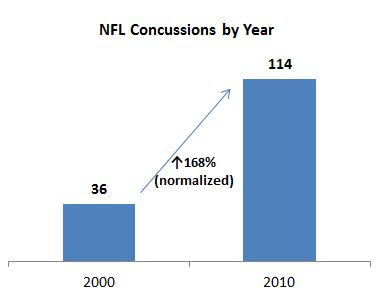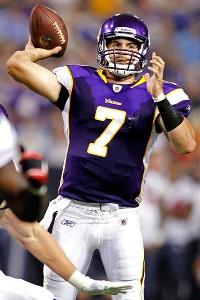I remember it being my freshman year of high school and I
had been playing wide receiver for the freshman football team all season long
with no injuries or setbacks. It was a
warm October night in the last game against our rival high school, St.
Mary’s. We were playing at St. Mary’s on
their freshman football field, which was not in very good condition. There were divots and potholes everywhere. This made me nervous every time I ran my routes
because I thought I was going to hurt my ankle. In the fourth quarter I went out for a pass, caught it, turned, and was
hit in the helmet by one of the defenders. Sure enough, I was hurt, but not from the poor field. I remember feeling sort of numb and
dazed. I didn’t know what to do so I
just laid there flat on my back until the trainer came out to examine me. He propped me up and shined a flashlight in
my eyes. I remember him saying
“concussion” to the other trainer. Luckily I received a minor one and didn’t experience much memory loss or
other serious symptoms. I have been
fortunate enough to not endure another one and I hope to never experience one
ever again.
A concussion is defined as the most common type of traumatic brain
injury. As Toni Monkovic wrote in the New York Times in November 2011, “a concussion is not a bruise
to the brain caused by hitting a hard surface. Indeed, no physical swelling or
bleeding is usually seen on radiological scans. The injury generally occurs
when the head either accelerates rapidly and then is stopped, or is spun
rapidly.” The term is most frequently used when talking
about sports and sports medicine. Physical symptoms of concussions include headaches, blurred vision,
dizziness, vomiting, nausea, lack of motor coordination and difficulty
balancing. Cognitive and emotional
symptoms of concussions include confusion, disorientation and difficulty
focusing attention. In the United
States, there is an estimated 1.4 to 3.6 million sports-related concussions annually. Football is the leading contributor in this
statistic and many occur in the high school, college and professional level.
I met up with Scott Horton, a Pima Community College
athletic trainer, to get a better understanding of concussions, how they affect
the body and what athletes can do to attempt to prevent them from happening.
“Concussions aren’t really classified anymore,” Horton
said. “A concussion’s a concussion. The severity aspect you kind of see just in
terms of recovery time. A more severe
concussion takes longer to recover. Personally,
that’s kind of how I classify them.”
Treatment involves monitoring and rest. Athletes typically receive tests and the
trainer decides when the athlete can play again.
“A typical recovery time, I would say, is about a
little over a week to be game-ready,” Horton said. “You have to be careful though because once
you receive a concussion you are four times more likely to have another one.”
 |
| Pima Football |
Pima Community College is taking concussions very
seriously and with the football season over and many concussions coming and
going, the athletic trainers have performed tests on the athletes sustaining
the injury. Helmet to helmet hits are
the most likely source of concussions in football according to Jeannine Stein of the Los Angeles Times, and researchers are
trying to develop new ways of preventing head and neck damage.
When asked if Pima Football would take a different
approach in the use of their helmets, Horton said, “If there was a helmet on
the market that absolutely eliminated concussions, then everyone would have
it. It’s hard to say which helmets are
more effective or less effective.”
 |
| Xenith helmet |
Pima uses Riddell helmets and Horton says the Aztecs
have not considered changing to a different helmet.
The new Xenith helmet is the talk of the NFL. According to NFL inside reports, it supposedly
lowers the risk of concussions. Unlike
traditional foam helmets, the Xenith helmet is comprised of 18 thermoplastic
shock absorbers that release air upon impact like an airbag in a car. Theoretically, this helmet reduces the risk
of head trauma and should reduce the amount of athletes from sustaining head
related injuries.
In the NFL during the past two years, concussions have risen at an
astounding rate. Since then there have been more than 100 concussions coming from clean hits and dirty ones, big hits and relatively minor ones.
 Some notable players receiving concussions were Indianapolis Colts’
receiver Austin Collie, Arizona Cardinals’ quarterback Kevin Kolb, Philadelphia
Eagles’ receiver DeSean Jackson, and Philadelphia Eagles’ quarterback Michael Vick.
Some notable players receiving concussions were Indianapolis Colts’
receiver Austin Collie, Arizona Cardinals’ quarterback Kevin Kolb, Philadelphia
Eagles’ receiver DeSean Jackson, and Philadelphia Eagles’ quarterback Michael Vick.
Collie was hurt the most when it came to head injuries. In 2010, Collie suffered three concussions, missing seven games, and is now in an effort to minimize his risks for the rest of the 2011 season. Twelve weeks have passed in the 2011 season and Collie has been active for ever game.
The 25-year-old Collie says he doesn't give much thought to whether brain injuries he suffers on the field now could affect him when he's 35 or 55 or 75.
"I've known players who play with nine or ten concussions and who have lived on to have successful careers and haven't had any symptoms later on in life, so everyone is different," Collie said on KHTK, via SportsRadioInterviews.com.
A study commissioned by the NFL reported that Alzheimer's disease or similar memory-related diseases appear to have been diagnosed in the league's former players vastly more often than in the national population — including a rate of 19 times the normal rate for men ages 30 through 49.
A survey was conducted in 2000 of over 1,000 former NFL players and found that more than 60 percent of the participants had experienced at least one concussion. That is an astounding rate due to the numbers and has led the NFL to change its rules.
A survey was conducted in 2000 of over 1,000 former NFL players and found that more than 60 percent of the participants had experienced at least one concussion. That is an astounding rate due to the numbers and has led the NFL to change its rules.
The NFL rule used to be that you could return to practice or to a game
once your concussions symptoms resided, but now, players are required to be
removed from a game or practice if they exhibit any signs of concussion
symptoms and are not allowed to return that day.
This came to much chagrin from the NFL players and coaches. The long-term effects are too detrimental to
one’s health. At least in today’s game
there are more protective plastic helmets and not the leather ones worn back in
the early part of the NFL. There would
surely be many more injuries than there already are with the athletes playing
today and some of the hits occurring in games.
 Concussions don’t just occur in football; they also happen in soccer and
basketball more often than you may think.
Concussions don’t just occur in football; they also happen in soccer and
basketball more often than you may think.
One Saturday morning a couple years back, I remember attending a soccer
game in which my sister Rachel Sargent was playing in. The game was going smoothly as most do, but
just a couple minutes after halftime I watched as my sister went up to head a
ball in the air and as she came back down she immediately fell to the
ground. Unable to stand back up due to
the dizziness and unbalance, she sat there, mortified at what happened and
didn’t know what to do.
“I remember
not remembering anything that was going on, if that makes any sense,” Rachel
said when asked about her
concussion. “I
do remember the pounding I felt in my head and I began to feel extremely dizzy. My first instinct was to get off the field
and get out of the way. I wasn't walking
straight so I had to be carried to the car by a teammates’ mom and taken to the
ER.”
At the emergency room, Rachel explained how she encountered some
amnesia and disorientation.
“It was a weird feeling and definitely one I never want to
experience again,” Rachel said. “I was
really freaked out for a while after and I contemplated quitting sports
altogether.”
 |
| Travares Peterson |
In 2009, former Pima basketball player Travares
Peterson sustained a concussion in the National Junior College Athletic
Association Division II Tournament. He
was diagnosed hours after it happened by receiving an X-ray from the hospital. Once he was cleared from the hospital, he was
told not to be active for seven days due to the chance of having a severe
second concussion.
“The steps I took to become cleared to play was paying
attention to all the guidelines the trainers and doctors had for me,” Peterson
said.
When I asked for tips to avoid concussions, he
replied, “Concussions in sports are gonna happen. I would just suggest that athletes should do
what they are comfortable doing on the playing field or court and have no worries
about getting hurt.”
So if you are to receive a concussion in sports, here are some tips for further prevention.
Always wear proper footwear for the sport you are participating in. Concussions can be caused when a player slips and hits his head on the way down.
Wear helmets in football, baseball and ice hockey. Never risk playing without one, even if it is a pickup game.
Learn some basic first aid to treat concussions. Keep the victim awake and talking, unless unconscious, and prevent them from moving until an ambulance arrives.
According to TeensHealth, every 21 seconds a concussion or other serious brain injury happens in the United States. Concussions are a part of sports and athletes need to be prepared for them happening at any time.




